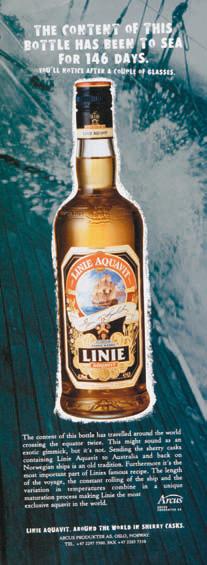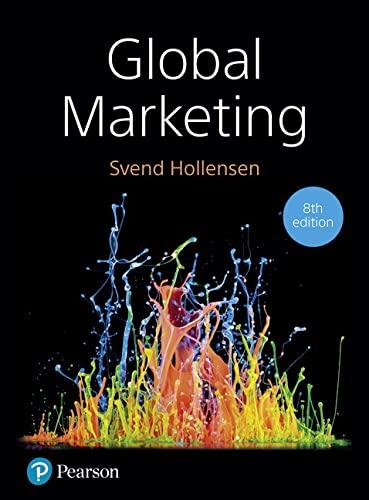Lysholm Linie Aquavit is marketed by the Norwegian spirits manufacturer Arcus Group (www.arcus.no). In 2018, it had
Question:
Lysholm Linie Aquavit is marketed by the Norwegian spirits manufacturer Arcus Group (www.arcus.no).
In 2018, it had approximately 2.7 billion Norwegian kroner (NOK) (€212 million) in sales, NOK132 million (€23 million) in net profit and 500 employees.
Around half of the Arcus sales are generated outside Norway.
Aquavit (which means ‘water of life’), a slightly yellow or colourless alcoholic liquor, is produced in the Scandinavian countries by redistilling neutral spirits such as those made from grain or potatoes and flavouring them with caraway seeds. It is often consumed as an aperitif.
The alcohol content in the various aquavits varies somewhat, but starts at 37.5 per cent. Most brands contain about 40 per cent alcohol but Lysholm Linie Aquavit has an alcohol content of 41.5 per cent.
(Lysholm is the name of the distillery in Trondheim where the aquavit is made; hereafter we refer to the spirit as Linie Aquavit.)
The history of Aquavit
Aquavit was originally used for medicinal purposes, but from the 1700s stills became commonplace in Scandinavian homes.
The definition of aquavit becomes complicated when you try to distinguish it and other spirits popular in the northern climate. The term ‘schnapps’, for instance, is widely used in Germany, Switzerland and Scandinavia (the Danish say ‘snaps’) to mean any sort of neutral spirits, flavoured or otherwise. Then there’s ‘brannvin’, a term used similarly in Sweden.
(Like the Dutch word ‘brandewijn’ from which we derive the word ‘brandy’, it means burnt wine.) The famous Swedish vodka Absolut began life in 1879 as a product called ‘Absolut Renat Brannvin’, which might be translated as ‘absolutely pure schnapps’, said to have been distilled 10 times. However, the Swedish government’s alcohol monopoly launched Absolut as an international brand in 1979, and labelled it vodka.
Making Linie Aquavit
Caraway is the most important herb in aquavit, but the mixture of herbs varies from brand to brand.
Linie Aquavit is derived from Norwegian potato alcohol blended with spices and herbal infusions, and caraway and aniseed predominate. After the alcohol and the herbs have been mixed, the aquavit is poured into 500-litre oak barrels. Norwegian specialists travel to Spain for the express purpose of selecting the best barrels from those used in the production of Oloroso sherry. Sherry casks are used because they remove the raw, more volatile aspects of the liquor; the aquavit takes on a golden hue, and the residual sherry imparts a gentle sweetness.
Many theories have been put forward to explain how the man behind Linie Aquavit, Jørgen B.
Lysholm, came up with the idea of sending aquavit around the world on sailboats in sherry casks in order to produce the special flavour. In the early 1800s, the family tried to export aquavit to the West Indies, but the ship, Trondheim’s Prøve, returned with its cargo unsold. This is when they discovered the beneficial effects the long ocean voyage and the special storage had on the aquavit: the length of the journey, the constant gentle rocking of the boat and the variation in temperature on deck all helped give Linie Aquavit its characteristic taste. Lysholm subsequently commercialized his maturation method and this is still how things are done today.
Linie Aquavit has one of Norway’s long-established shipping companies as its steady travel partner.
The first Wilhelmsen liner carrying Linie Aquavit set sail in 1927. Since that time, Wilhelmsen has been the sole carrier of this distinguished product. The barrels are tightly secured in specially designed cribs before being loaded onto containers, which remain on deck during the entire journey. The journey from Norway to Australia and back again takes four-anda-
half months and crosses the equator (or the line, as sailors prefer to call it) twice. In fact, this is where Linie Aquavit gets its name. On the back of each bottle is the name of the ship and the date that it first crossed the equator.
International sales of Linie Aquavit and Vikingfjord vodka
Arcus AS is Norway’s sole manufacturer of hard liquor and it is this company which produces Linie Aquavit. The company also taps (i.e. bottles) wine from wine producers all over the world and imports a select range of bottled wines. With a market share of about 30 per cent, Arcus AS is the leading player in the Norwegian wine and spirits market.

The international aquavit markets (primarily Sweden, Norway, Denmark, Germany and the US) are dominated (except the last) by local aquavit brands.
At present, Linie Aquavit is the market leader in Norway with a 25 per cent market share. In Denmark and Sweden the market share is 10 per cent. Germany is the most important export market and Linie Aqavit holds 10 per cent of the aquavit market in competition with brands like Malteserkreutz (also sold by Arcus) and Bommerlunde.
Arcus has established a subsidiary in Sweden, but elsewhere it only uses export modes (foreign-based intermediaries – distributors).
Until 2009, Linie Aquavit was distributed by the Berentzen Group in Germany. In April 2009, it transferred its German distribution to Eggers & Franke (family-owned company, located in Bremen/Germany), offered a broad assortment of spirit brands, especially for retailers and the restaurant, hotel and catering industry, not only for Germany, but also for the rest of Europe. With Eggers & Franke as its distribution partner, Arcus hoped that Linie Aquavit could strengthen its market position in the southern part of Germany, and in the general on-trade segment (bars, restaurants and hotels), where Linie Aquavit has, until now, been relatively weak. The sales volume for Linie Aquavit in Germany was around 800,000 bottles in 2016. Their ambition is to push this figure up to one million bottles. In 2017, Eggers & Franke had a total sale of more than 20 million bottles. In May 2018 Eggers & Franke was acquired by family-owned Rotkäppchen-Mumm (based in Freyburg, Saxony-Anhalt, not far from Leipzig)
which is one of the Europe’s leading producers of sparkling wine and wine. It has 670 employees. In 2017 it had total sales of 256 million bottles (of which 48 million are sold to the spirits market) and revenue of €945 million.
Linie Aquavit has long been the national spirit of Norway and one of the flagships in Arcus’s portfolio.
However, with more than 80 years’ experience as a supplier and producer of spirits and wine, Arcus has a very diverse portfolio, including international premium brands such Vikingfjord Vodka.
Questions
1. What are the main advantages and disadvantages for Arcus of using export modes, compared with other entry modes, for its Linie Aquavit?
2. What should be Arcus’s main criteria for selecting new distributors or cooperation partners for Linie Aquavit in new markets?
3. Would it be possible to pursue an international branding strategy for Linie Aquavit?
Step by Step Answer:






